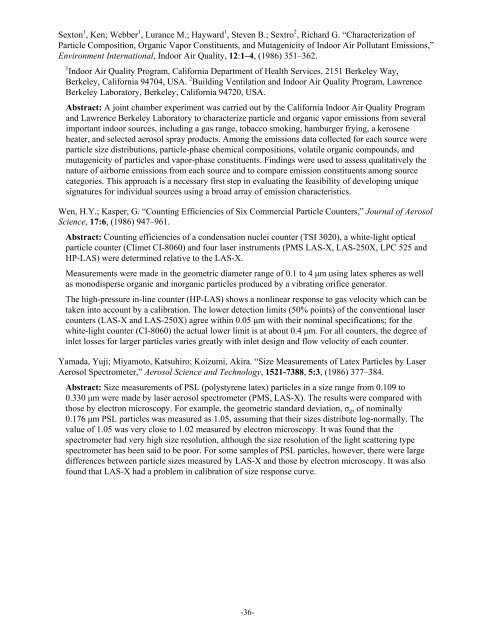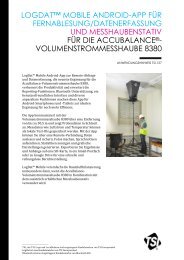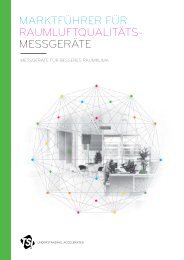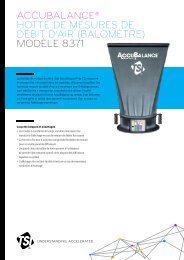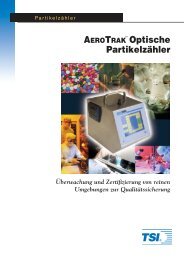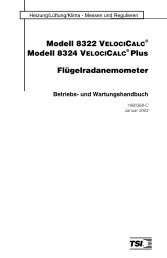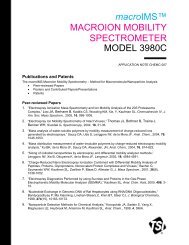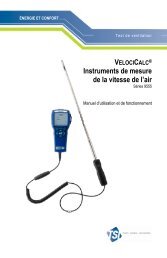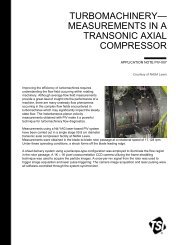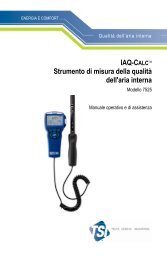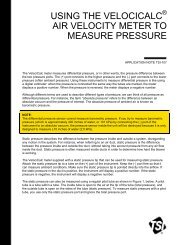Model 3340 Laser Aerosol Spectrometer Bibliography - Tsi
Model 3340 Laser Aerosol Spectrometer Bibliography - Tsi
Model 3340 Laser Aerosol Spectrometer Bibliography - Tsi
You also want an ePaper? Increase the reach of your titles
YUMPU automatically turns print PDFs into web optimized ePapers that Google loves.
Sexton 1 , Ken; Webber 1 , Lurance M.; Hayward 1 , Steven B.; Sextro 2 , Richard G. “Characterization of<br />
Particle Composition, Organic Vapor Constituents, and Mutagenicity of Indoor Air Pollutant Emissions,”<br />
Environment International, Indoor Air Quality, 12:1–4, (1986) 351–362.<br />
1 Indoor Air Quality Program, California Department of Health Services, 2151 Berkeley Way,<br />
Berkeley, California 94704, USA. 2 Building Ventilation and Indoor Air Quality Program, Lawrence<br />
Berkeley Laboratory, Berkeley, California 94720, USA.<br />
Abstract: A joint chamber experiment was carried out by the California Indoor Air Quality Program<br />
and Lawrence Berkeley Laboratory to characterize particle and organic vapor emissions from several<br />
important indoor sources, including a gas range, tobacco smoking, hamburger frying, a kerosene<br />
heater, and selected aerosol spray products. Among the emissions data collected for each source were<br />
particle size distributions, particle-phase chemical compositions, volatile organic compounds, and<br />
mutagenicity of particles and vapor-phase constituents. Findings were used to assess qualitatively the<br />
nature of airborne emissions from each source and to compare emission constituents among source<br />
categories. This approach is a necessary first step in evaluating the feasibility of developing unique<br />
signatures for individual sources using a broad array of emission characteristics.<br />
Wen, H.Y.; Kasper, G. “Counting Efficiencies of Six Commercial Particle Counters,” Journal of <strong>Aerosol</strong><br />
Science, 17:6, (1986) 947–961.<br />
Abstract: Counting efficiencies of a condensation nuclei counter (TSI 3020), a white-light optical<br />
particle counter (Climet CI-8060) and four laser instruments (PMS LAS-X, LAS-250X, LPC 525 and<br />
HP-LAS) were determined relative to the LAS-X.<br />
Measurements were made in the geometric diameter range of 0.1 to 4 μm using latex spheres as well<br />
as monodisperse organic and inorganic particles produced by a vibrating orifice generator.<br />
The high-pressure in-line counter (HP-LAS) shows a nonlinear response to gas velocity which can be<br />
taken into account by a calibration. The lower detection limits (50% points) of the conventional laser<br />
counters (LAS-X and LAS-250X) agree within 0.05 μm with their nominal specifications; for the<br />
white-light counter (CI-8060) the actual lower limit is at about 0.4 μm. For all counters, the degree of<br />
inlet losses for larger particles varies greatly with inlet design and flow velocity of each counter.<br />
Yamada, Yuji; Miyamoto, Katsuhiro; Koizumi, Akira. “Size Measurements of Latex Particles by <strong>Laser</strong><br />
<strong>Aerosol</strong> <strong>Spectrometer</strong>,” <strong>Aerosol</strong> Science and Technology, 1521-7388, 5:3, (1986) 377–384.<br />
Abstract: Size measurements of PSL (polystyrene latex) particles in a size range from 0.109 to<br />
0.330 μm were made by laser aerosol spectrometer (PMS, LAS-X). The results were compared with<br />
those by electron microscopy. For example, the geometric standard deviation, σg, of nominally<br />
0.176 μm PSL particles was measured as 1.05, assuming that their sizes distribute log-normally. The<br />
value of 1.05 was very close to 1.02 measured by electron microscopy. It was found that the<br />
spectrometer had very high size resolution, although the size resolution of the light scattering type<br />
spectrometer has been said to be poor. For some samples of PSL particles, however, there were large<br />
differences between particle sizes measured by LAS-X and those by electron microscopy. It was also<br />
found that LAS-X had a problem in calibration of size response curve.<br />
-36-


